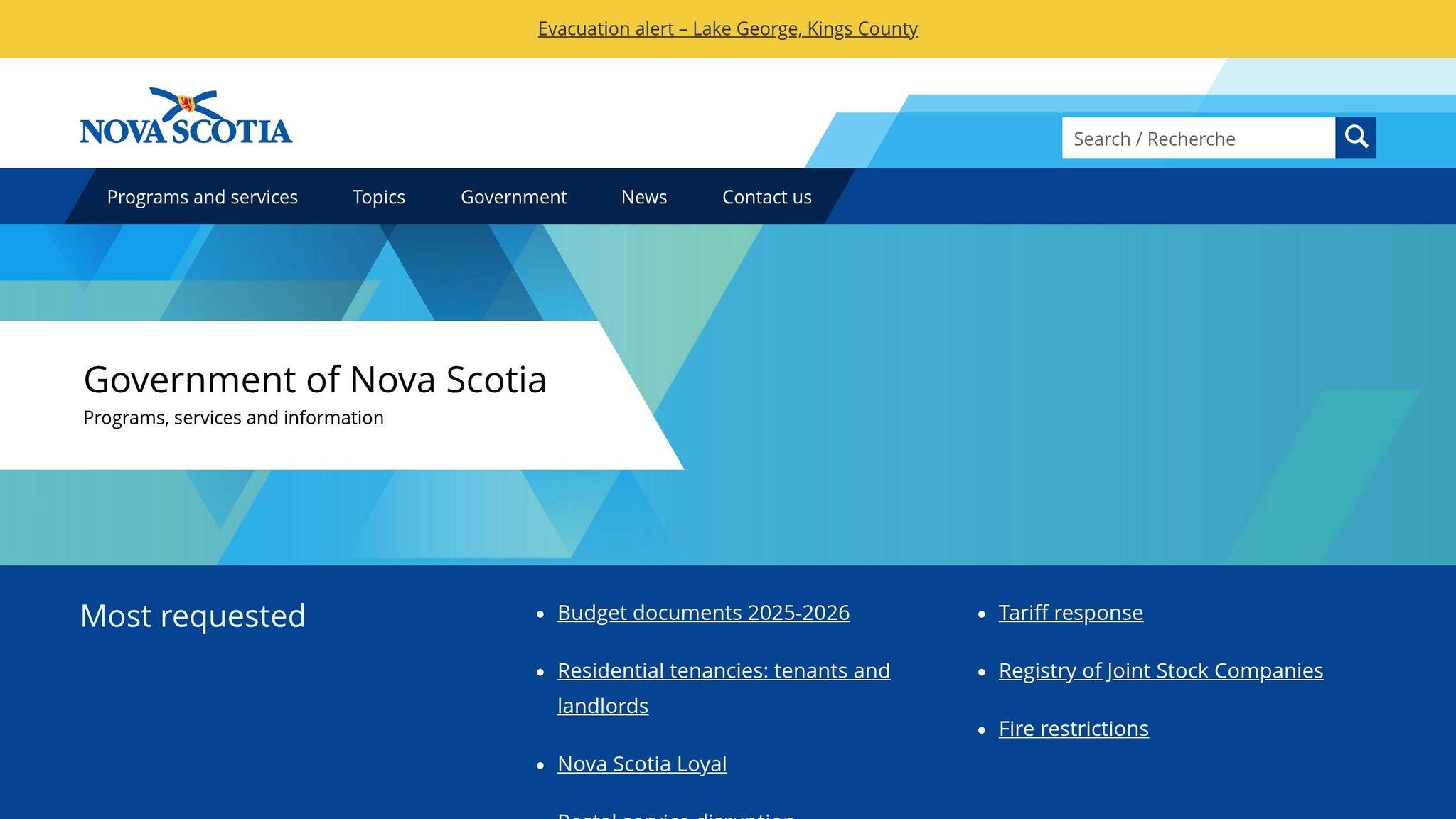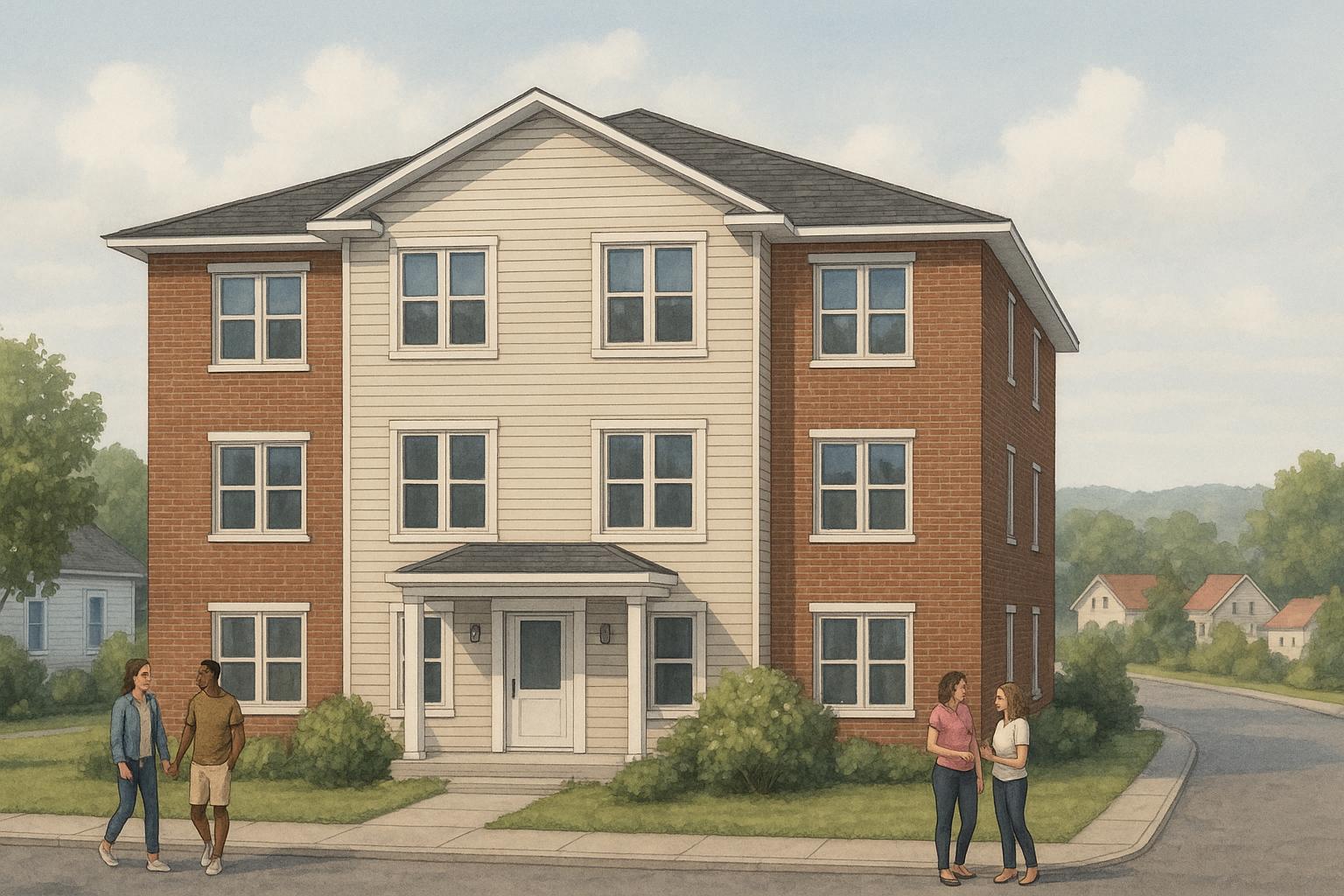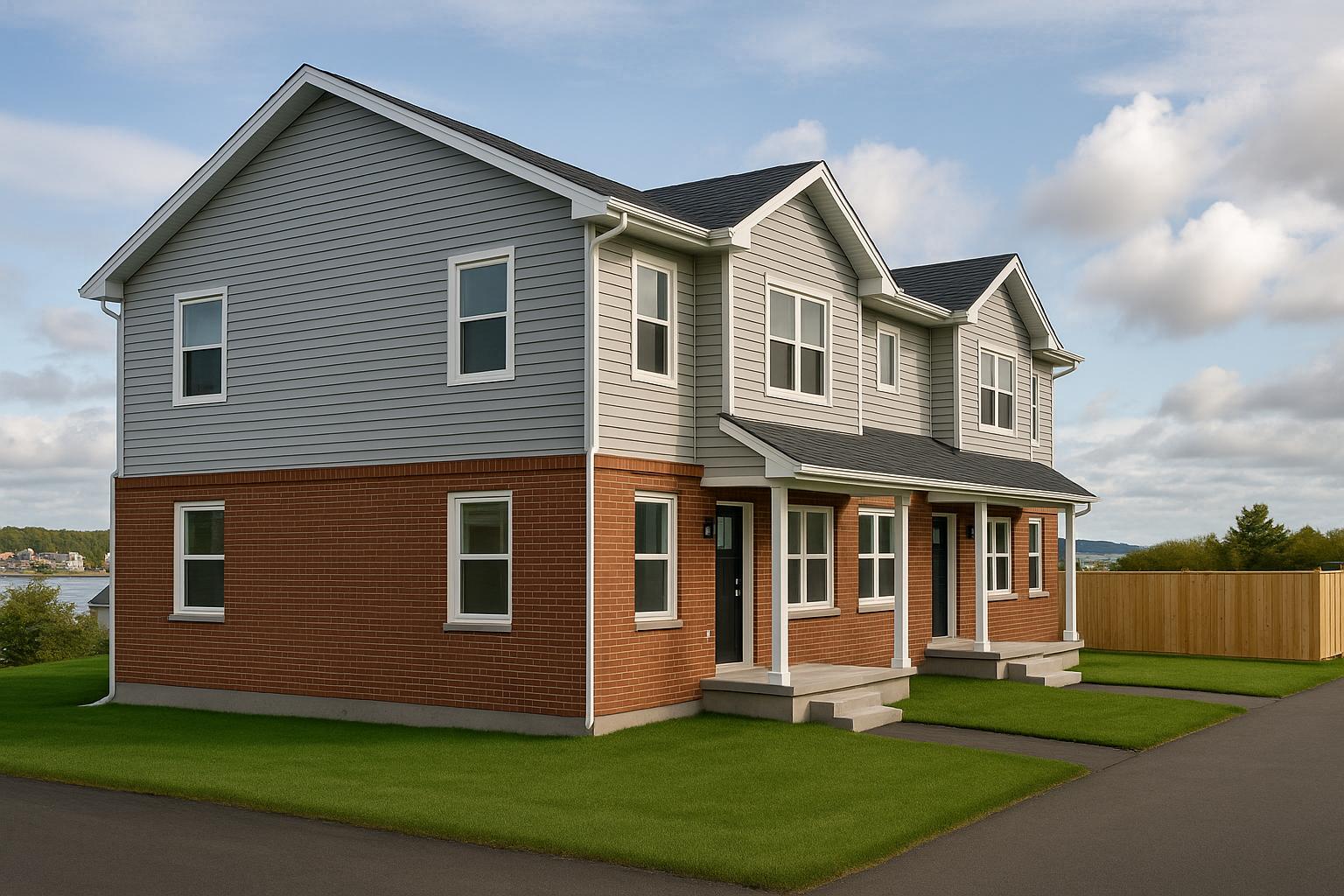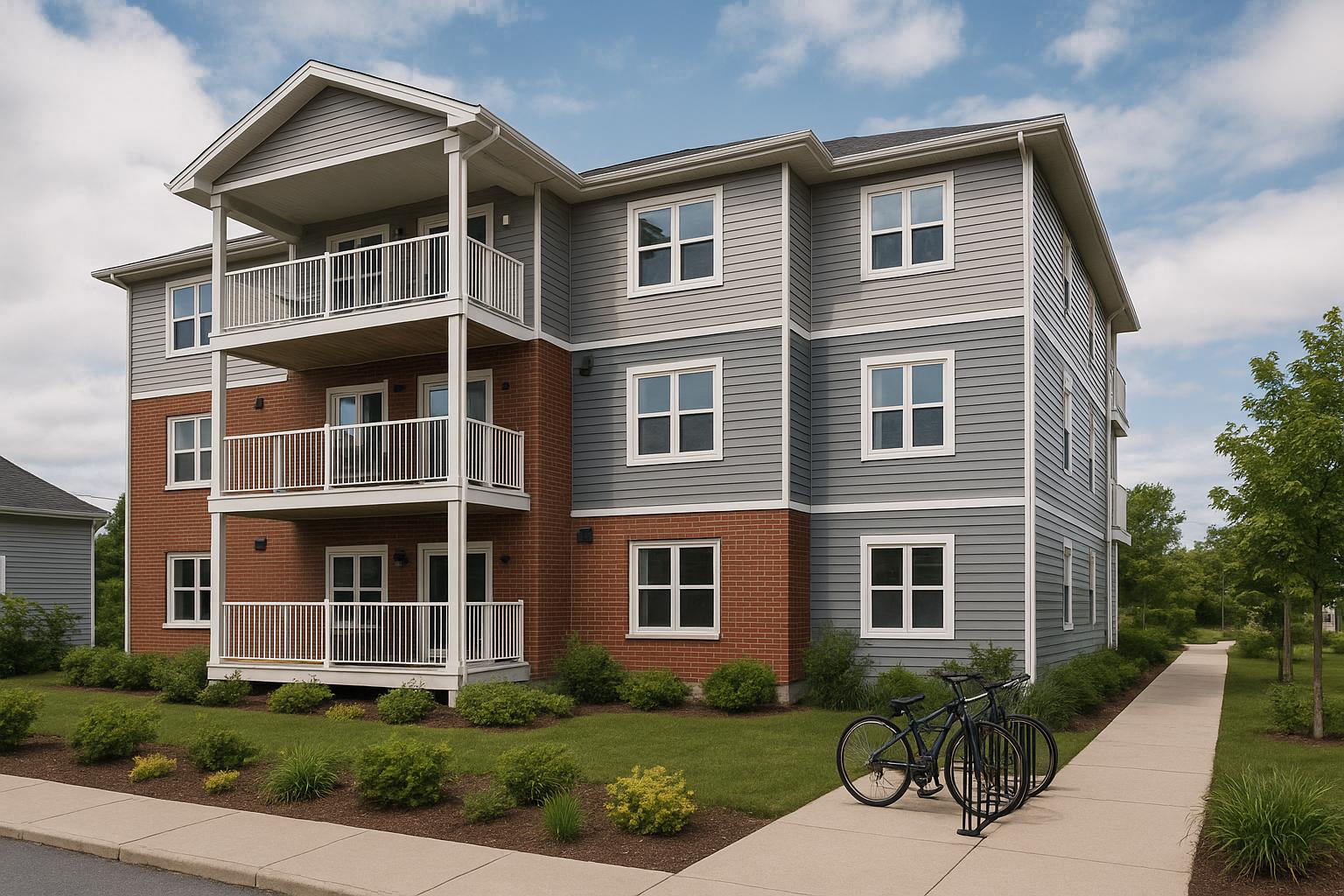Building smart home ready rentals in Nova Scotia during the construction phase saves money, reduces future renovation hassles, and meets tenant expectations in a competitive rental market. Features like keyless entry, smart thermostats, and fibre-ready internet infrastructure are becoming standard, with modern units renting for $1,950–$2,100/month. Poor planning can lead to delays and cost overruns, sometimes adding up to $47,000.
Key Takeaways:
- Smart Features to Include: Pre-wiring for high-speed internet, smart climate control, enhanced security systems, smart lighting, and energy monitoring.
- Construction Benefits: Early integration avoids costly retrofits and ensures systems work together.
- Financial Upside: Smart rentals see annual returns of 12%–20%.
- Regulatory Compliance: Follow Nova Scotia’s electrical, energy, and fire safety codes.
Home Automation 101: A Builder’s Guide to Smart Homes on the Job Site
What Smart Home Ready Means in Nova Scotia

Smart home ready properties are designed with infrastructure that supports both current and future technologies, eliminating the need for extensive renovations down the line. This forward-thinking approach ensures that properties remain competitive by accommodating technological advancements, all while avoiding disruptions caused by construction. This groundwork is essential for integrating the features and meeting the local compliance requirements outlined below.
Smart Home Features for Multi-Unit Rentals
The backbone of any smart home ready property is high-speed internet infrastructure. To meet growing connectivity needs, install Cat 6 or Cat 6a ethernet wiring with multiple connection points, and ensure conduits are fibre-ready.
Other key elements include:
- Electrical Upgrades: Add circuits for high-power devices, USB outlets in accessible locations, and electrical panels with room for future expansion. These upgrades support smart appliances, electric vehicle chargers, and simultaneous device use.
- Climate Control Systems: Ensure wiring supports programmable and smart thermostats, including dedicated C-wires. Design ductwork to work seamlessly with smart vents and air quality monitors for enhanced climate control.
- Security System Readiness: Pre-wire entry points for cameras, smart locks, and alarms. Use low-voltage wiring, reinforced structural elements for locks, and well-placed conduits for exterior cameras.
- Smart Lighting: Include neutral wires at all switches, dimmer-compatible fixtures, and strategically placed outlets for smart hubs and wireless devices to improve connectivity.
- Energy Monitoring: Install smart electrical panels with built-in monitoring to track energy use, reduce waste, and cut utility costs compared to older systems.
Each of these features ensures adaptability to future technologies while also boosting rental appeal and long-term cost efficiency.
Local Standards and Regulations
In Nova Scotia, adhering to local codes and guidelines is crucial for creating a smart home ready property that meets both current and future needs. Here's a breakdown of the key standards:
- Electrical Code Compliance: Smart home wiring and devices must meet CSA standards, ensuring proper grounding and surge protection for sensitive electronics.
- Energy Efficiency: Smart thermostats and energy monitoring systems align with Nova Scotia's building standards, helping properties meet energy performance goals while delivering operational benefits.
- Fire Safety: Provincial fire codes require hardwired and interconnected smart smoke detectors. Wireless components must meet strict reliability standards.
- Accessibility: Voice-controlled systems and smartphone-based solutions should be integrated during construction to serve tenants with varying needs.
- Permits and Inspections: Municipalities like Halifax Regional Municipality may require additional documentation for smart home infrastructure, so it's essential to understand local permitting processes.
- Telecommunications: The Canadian Radio-television and Telecommunications Commission (CRTC) sets regulations for internet infrastructure. Properties should be designed to accommodate multiple service providers and adapt to evolving minimum speed requirements.
Planning Infrastructure for Smart Technology
Incorporating smart technology infrastructure during the construction phase is a smart way to prepare your rental property for the future. By laying the groundwork early, you can avoid disruptive and costly retrofits as new technologies emerge.
Smart Wiring and Connectivity
A reliable network starts with structured cabling. Installing Cat6 or Cat6A Ethernet cables ensures your property can support Wi-Fi access points, security cameras, smart appliances, and central control systems seamlessly.
Your electrical system should also be designed with both current and future needs in mind. For example, smart lighting circuits benefit from centralised wiring that connects to control panels, keeping load circuits separate from control wiring. This setup allows for features like dimming and scene control while reducing interference between power and data signals. To complete the lighting control system, run low-voltage data cables to keypads and touchscreens.
Here are some key considerations for wiring and connectivity:
- Opt for 200A+ electrical panels to handle current loads and accommodate future additions, such as EV chargers or solar power systems.
- Use dedicated circuits for low-voltage wiring to avoid signal interference.
- Ensure all wiring complies with the Canadian Electrical Code, Part 1. This means securing the necessary permits and hiring certified professionals, such as those with Electrical Construction or Communications Cabling Specialist credentials.
Proper wiring not only supports smart devices but also enhances energy efficiency across your property.
Energy-Efficient Systems and Smart Controls
Smart controls go hand-in-hand with energy-efficient systems. For instance, integrating smart thermostats into your HVAC system allows for precise climate management, which can be adjusted remotely and in real time. This not only enhances tenant comfort but also reduces energy consumption.
To ensure reliability, dedicate separate circuits to high-demand devices. This prevents overloads and ensures that all connected systems - whether lighting, appliances, or others - operate smoothly. Once you've optimised your energy systems, make sure your design allows for straightforward future upgrades.
Future-Proofing for New Technology
Designing with the future in mind is crucial. Include extra conduit and panels with additional circuit spaces so you can add new cables or components without major disruptions. Modular wiring methods, like adjustable junction boxes, make upgrades easier and less invasive.
Preparing for higher bandwidth demands is equally important. Consider provisions for fibre optic cabling to ensure your property remains connected as technology evolves.
Adopting an integrated construction approach - where electrical, networking, and HVAC systems are planned and installed together - can prevent compatibility issues. This unified strategy not only simplifies installation but also reduces the risk of expensive retrofits down the line.
sbb-itb-16b8a48
Choosing and Installing Smart Technologies
Once your smart infrastructure is in place, the next step is selecting and setting up devices that genuinely add value. Focus on smart technologies that improve tenant satisfaction and increase the long-term value of your property. It's essential to choose devices that can handle Nova Scotia's unique climate while meeting the practical demands of multi-unit rental properties.
Key Smart Devices for Rental Properties
Here are some smart devices that can make a real difference:
- Smart thermostats: Look for models suited to Nova Scotia's weather, offering remote control, energy monitoring, and distributed sensors to maintain consistent temperatures throughout the property.
- Keyless entry systems: Opt for systems that generate temporary access codes and are built to withstand the province's maritime conditions.
- Video doorbells: Enhance security with devices that feature two-way audio, allowing for remote communication with visitors.
- Automated smart lighting: Install motion-activated and programmable lighting for both interior and exterior spaces to improve convenience and energy efficiency.
- Leak detectors: Choose detectors that provide early alerts and can automatically shut off water to prevent costly damage.
Once you've identified the right devices, make sure to evaluate their compatibility and costs to ensure they meet your property's needs over the long term.
Checking Compatibility and Cost
When selecting smart home technologies, compatibility and cost are two critical factors to consider. Ensure the devices are certified for use in Canada and can withstand Nova Scotia's often harsh weather conditions. It's also important to weigh the initial investment against potential savings on energy and maintenance.
Key cost considerations include:
- Upfront expenses: Account for the cost of each device, as well as any necessary rewiring or modifications during installation.
- Long-term savings: Factor in potential reductions in energy usage and ongoing maintenance costs.
To simplify maintenance and minimise compatibility issues, aim to integrate devices on a common smart home platform.
Using Government Incentives and Grants
After determining costs and compatibility, take advantage of government programs that can help offset the upfront investment. Energy efficiency initiatives often provide rebates for upgrades that include smart controls. Coordinating these installations with larger energy-efficiency projects may also increase your eligibility for additional incentives.
Local municipalities and agencies may offer property tax breaks or grants for energy-efficient upgrades. Check with your local planning department to learn about available programs and ensure you meet documentation requirements, such as providing detailed receipts and professional invoices.
Increasing Value Through Smart Home Integration
Adding smart home technology to rental properties isn't just a modern trend - it's a smart investment. For multi-unit rentals, these features can drive higher rental income, lower operating expenses, and enhance long-term property value, especially when incorporated during construction.
Meeting Tenant Expectations and Market Demands
What used to be seen as high-end extras are now becoming standard expectations for many tenants. Properties equipped with smart home features often command higher rents compared to traditional units. This reflects how much tenants value amenities that simplify their lives and add convenience.
Take programmable heating controls, for example. These not only reduce utility bills but also offer tenants greater control over their comfort. Similarly, keyless entry systems make life easier by allowing simple access for guests or service providers. Properties with these advanced features tend to lease faster and appeal to tenants who value modern, tech-savvy living. This tenant-focused approach also streamlines the construction process, reducing risks and boosting efficiency.
Integrated Construction vs. Traditional Approaches
To deliver the full benefits of smart home technology, the construction process needs to be as forward-thinking as the technology itself. Traditional construction methods, where different trades work independently, can lead to hiccups like compatibility issues, delays, and unexpected costs. These challenges can undermine the vision of a seamlessly integrated smart home.
That’s where an integrated design-build approach stands out. By planning and managing smart systems under one unified framework from the start, this method ensures smoother coordination. It reduces delays, keeps costs in check, and simplifies project management by eliminating the need to juggle multiple contractors. This cohesive strategy helps bring the smart home vision to life without unnecessary complications.
Maintaining Long-Term Smart Home Benefits
The work doesn’t stop once the systems are installed. To preserve the value of your smart home investment, ongoing maintenance and updates are essential. As technology evolves, plan for system upgrades and occasional component replacements to keep everything running smoothly. Budgeting for these updates ensures your property stays compatible with emerging platforms.
Keeping detailed installation records and scheduling regular updates can make troubleshooting easier and keep tenants happy. Adding backup options, like manual overrides for smart locks or thermostats, provides peace of mind during system updates or technical glitches. These thoughtful measures help maintain the appeal and functionality of your smart home features over time.
Conclusion: Building for the Future
From the very beginning, designing your multi-unit rental with a solid smart home infrastructure can save you from expensive retrofits down the line.
By treating smart home readiness as a fundamental part of your construction plan, you can ensure that your property is equipped with electrical systems capable of supporting advanced smart controls. This approach allows for smooth integration of smart technology across the entire building.
Fixed-price construction offers a streamlined way to incorporate these features, bringing all system installations under one roof and reducing the risk of costly adjustments later.
Adding smart home features not only enhances your property's appeal but also improves its operational efficiency. As tenants increasingly expect modern conveniences and technology continues to evolve, having a smart-ready property helps maintain its value in a competitive market.
In Nova Scotia, the construction industry is leaning toward integrated methods that simplify the process by reducing the need to coordinate multiple trades. Property owners who adopt this forward-thinking approach - by embedding smart home readiness into their plans - can enjoy better cash flow and attract high-quality tenants. Taking this step now can position your property for long-term success.
FAQs
What are the cost savings and long-term benefits of including smart home technology when building a rental property in Nova Scotia?
Including smart home technology during the construction of a rental property in Nova Scotia can offer both immediate savings and long-term benefits. For instance, energy-efficient systems like smart thermostats, lighting, and appliances can cut utility costs by up to 15%. These systems work by optimizing energy usage and reducing waste, which translates into lower bills - a win for both property owners and tenants.
Beyond cost savings, smart features can increase property value by 3% to 5%, making your investment more lucrative over time. They also play a key role in attracting reliable tenants, boosting satisfaction, and justifying higher rental rates. By integrating these technologies during the construction phase, you ensure your property stays competitive, modern, and appealing in Nova Scotia's rental market.
What steps should property owners in Nova Scotia take to ensure their smart home infrastructure meets local codes and regulations?
To make sure your smart home setup aligns with Nova Scotia's building codes and regulations, start by reviewing the Nova Scotia Building Code Regulations. Staying up to date on changes, especially those related to energy efficiency and building safety, is crucial. Bringing in licensed professionals who understand these local standards is a key step to ensuring everything is installed correctly and meets the necessary requirements.
It's also a good idea to collaborate with electricians and contractors who have experience in smart home technology. They can help ensure your wiring, devices, and systems are compliant now and prepared for future standards. Taking this approach can save you from expensive fixes down the road and make the integration of smart technology into your home seamless.
How can I design a rental property to be ready for future smart home technologies?
To get your rental property ready for future smart home technologies, start by focusing on infrastructure that can grow with advancements. Consider installing smart wiring and cabling that can handle high-bandwidth devices, and make sure your electrical system is set up to support a variety of IoT gadgets. Adding energy-efficient features like smart thermostats, lighting, and appliances can also make a big difference - not just for tenant comfort but for lowering utility bills too.
It's smart to opt for systems based on open standards to keep things compatible with new tech as it emerges. On top of that, invest in a solid network setup, including strong Wi-Fi and readiness for 5G connectivity. Thinking ahead and incorporating these features during construction can save you money on future renovations, boost tenant satisfaction, and even increase your property's value over time.
Related Blog Posts
- Designing Your Dream Home in Nova Scotia: Top 10 Custom Home Trends for 2025
- Top 5 Home Design Trends in Halifax for 2025 (and How to Incorporate Them)
- Green Building in Nova Scotia: Top 10 Energy-Efficient Features for Your Custom Home
- Designing for Nova Scotia’s Climate: Storm-Resilient Homes from Roof to Foundation



